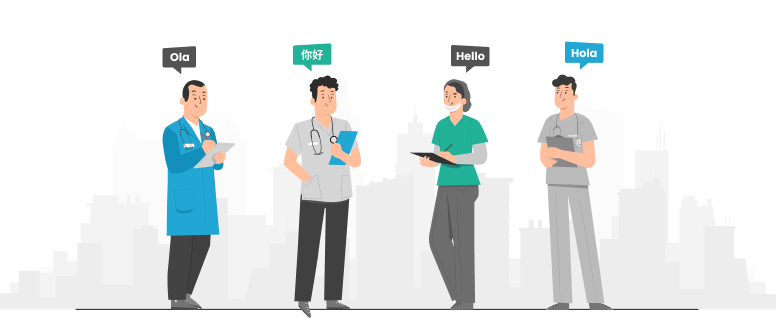Medical Transcriptionist record all aspects of a person’s health care such as their symptoms, their medical background, results of their medical providers’ examinations as well as their diagnostic tests along with their treatment plans. They are crucial to ensure continuity of treatment and communication between healthcare professionals.
Incorrect medical records could cause problems with insurance coverage or cause mistakes in treatment. Caregivers are required by law to keep accurate and current information on every patient.
Table of Content
- The Role of Medical Transcriptionists
- What Does a Medical Transcriptionist Do?
- Education and Training of Medical Transcriptionists
- Eligibility Criteria for Medical Transcriptionists
- Why Do You Need to See a Medical Transcriptionist?
- History of Medical Transcription
- Medical Stenographer Recorded Medical Information
- Future of Medical Transcription
- 1. Technologies are Constantly Evolving.
- 2. The Increase in Outsourcing
- 3. Market Growth
The Role of Medical Transcriptionists
Medical transcriptionists collaborate alongside healthcare professionals to ensure that every visit is recorded. And they ensure the complete record of the treatment and diagnosis along with any follow-up care.
Medical transcriptionists listen to doctors’ written notes and convert them into a clear and recorded report of the visit. They make sure that every aspect of the person’s medical background, diagnosis, and treatments are documented. Then, they utilize the documentation system of the hospital to record medical records which can be accessible during the next visit, or for transfer to another facility in the event of need.
What Does a Medical Transcriptionist Do?
Doctors, nurse practitioners, and other healthcare professionals write their private notes on each visit. Skilled Medical transcriptionists collect these notes and translate them into a complete account that details the appointment.
They utilize a template that is based on the kind of work they do. Every area that they cover has distinct needs. Sometimes, they get documents that have not been edited for speech-to-text translations. They edit and format the notes to transform them into a final document.
When they’re writing, expert medical transcriptionists employ their vast knowledge of medical terms and critical thinking abilities to ensure that errors are eliminated. If they find contradicting information, for instance, the person is identified as taking a drug that they are not allergic or intolerant to, they cease the transcription and seek clarification to ensure that the information is correct.
Education and Training of Medical Transcriptionists
Most medical transcriptionists have completed an accredited certificate program that covers classes on medical terms, anatomy, and medical specialties such as diagnostics, as well as Pharmacology.
Medical Language Specialists
A few students complete an associate’s degree program. Medical transcriptionists can be referred to as medical language specialists. They must have an exceptional grasp of punctuation and grammar.
Comprehending Complicated Medical Terms
They must also be able to comprehend complicated medical terms as well as surgical and medical procedures. Furthermore, they must possess good auditory processing abilities and recognize accents.
Eligibility Criteria for Medical Transcriptionists
The Association for Healthcare Documentation Integrity is the professional association to support medical transcriptionists. Medical transcriptionists are eligible to earn two types of certification depending on their level of years of experience.
-
Registered Healthcare Documentation Specialist
New Medical transcriptionists, when they’ve completed the medical transcription program take the exam to be a Registered Healthcare Documentation Specialist (RHDS). The test is available to those who have under two years of experience, or to transcriptionists working in only one area of expertise.
-
Certified Healthcare Document Specialist
Once they’ve obtained the RHDS certification, medical transcriptionists can be eligible to become certified as Certified Healthcare Documentation Specialists (CHDS). To earn their CHDS certification transcriptionists must possess more than two years’ work experience in an acute or multi-specialty setting.
They also must obtain an RHDS certification. To maintain their certification, RHDS transcriptionists have to complete twenty hours of continuing education every three years or take the exam again. To keep their CHDS accreditation, transcriptionists have to take 30 hours of continuing education every three years.
Why Do You Need to See a Medical Transcriptionist?
Medical transcriptionists work in the background alongside your doctor to ensure that your medical history is accurately recorded and passed on to other doctors as required. You won’t likely encounter them during the normal procedure of your care.
But, you can observe the results of their work by asking for documents from your doctor. It is a good idea to review your medical records in order to confirm the accuracy of your records.
The Health Insurance Portability and Accountability Act (HIPAA) provides you with the right to access and obtain copies of your medical records but with some restrictions. Many health providers allow an online portal to access information in your electronic medical records (EMR) through their websites.
If not then you’re still entitled to see your records, keep them secure, and ask for a correction if you think there’s an error.
History of Medical Transcription
Medical transcription as it’s now known is a fact that has been in existence from the beginning at the turn of the 20th century when the standardization of medical records and data was essential for research.
Medical Stenographer Recorded Medical Information
In the past, medical stenographers were recording medical information and took physicians’ dictations in shorthand. Thanks to the advent of audio recording equipment, doctors and transcribers were able to work simultaneously
Through the years, transcription equipment has evolved. From hand typewriters and then to electronic typewriters and then Word processors and, eventually by 2021, computers.
Storage Techniques
Storage techniques have also changed as well: from plastic disks to magnetic belts and cassettes with endless loops or digital records.
Speech recognition (SR) which is also known in the form of Continuous Speech Recognition (CSR) is being increasingly employed, as are medical transcriptions as well as, in certain cases, “editors” providing supplemental editing services.
Natural-language processing can take “automatic” transcription a step further, offering an interpretive capability that speech recognition by itself could not offer.
Short Handwritten Notes
In the past, medical records were made up of short handwritten notes which were placed in the patient’s medical file to be read by the primary doctor responsible for the patient’s treatment.
Then, the handwritten notes and written reports were combined into one patient file and then stored alongside hundreds of other patient records at the Medical Records Department.
If the need was to look over the files of a particular person, their files were pulled out of the filing cabinet and handed to the physician who requested it.
Duplicate Copies
To improve this manual process, numerous medical records documents were made in duplicate or in triplicate through carbon copies. Medical records have been transformed dramatically.
While some hospitals and physicians still keep documents on paper, the vast majority of them are now stored electronically.
Digital Formats
The digital format allows instant remote access for any doctor who has been legally authorized to access the patient’s information. Reports are electronically stored and printed when the requirement arises.
Today, many healthcare professionals work with handheld computers as well as personal assistants (PDAs) and are employing software on them to capture dictation.
Future of Medical Transcription
Medical transcription’s future is promising, however, if you are looking to stay current and stay ahead of your competition it is essential to embrace changes in the market and stay on top of the trends.
Here are the three most important trends to watch this year and in the future:
1. Technologies are Constantly Evolving.
There have been many improvements in technology for healthcare and systems, such as:
- Advanced voice recognition program; Voice recognition software getting more advanced doctors are recording health reports straight to the program using a computer rather than being transferred to a transcriptionist. Although it is a sophisticated system, the software may fail to translate medical terminology, and only a professional Medical transcriptionist will detect these mistakes.
- In the new electronic health record (EHR) system; Medical transcriptionists will be required to adhere to a structured data format. This is a collection of point-and-click fields as well as pull-down menus, macros, and templates that are structured. The system will provide a uniform method for maintaining digital records, which will help simplify medical record information and establish a common ground in the health record industry.
- Seamless connectivity and automation in the health sector; New technologies enable seamless connectivity which allows you to record and upload the data into a central database that the doctor can access. This in turn assists the Certified Medical transcriptionist in automating the transfer of information between different devices and personnel. Automatizing healthcare processes will enable them to offer superior, more secure, and high-quality services to patients.
- Advanced reporting methods; There’s a growing acceptance of web-based applications and automated devices for transcribing that are expected to replace traditional transcribing devices such as recorders. Also, there is a growing use of electronic word processors and consoles and other devices that have built-in speech recognition as well as memory storage systems which are essential to outsourcing medical transcription services.
- Secure process networks that are enhanced; With medical transcription becoming mobile and able to be done on tablets and mobile phones, it guarantees the protection of the information.
2. The Increase in Outsourcing
There’s a rising trend of both international and outsourcing of medical transcription services. Transcribers from abroad are being hired to produce transcriptions to reduce costs, and domestic transcribers are needed to correct medical reports that do not comply with the national standards. In addition, more businesses contract medical transcription to trusted Third-party providers.
The rise in outsourcing is due in large part to the following factors:
- It drastically reduces costs for hiring and equipment.
- Internet-connected technology allows access to Medical transcriptionists across the globe.
- There are more experienced Medical transcriptionists and third-party service providers who are able to efficiently complete the duties required of them.
- A medical transcription team that is globalized has a strict quality control process setup, to ensure that the client is satisfied.
3. Market Growth
The advancements in technology and increasing outsourcing have led to the growth of the market for medical transcription. Particularly they’ve led to an increase in the cost of medical transcriptionists who are skilled and an increase in third-party service companies and emerging markets.
The skilled personnel can be beneficial to medical transcription outsourcing and so it is expected that the demand for these will only increase.
There are transcriptionists who have had many years of instruction to understand various methods and terminologies in science which makes them extremely efficient in the field of medical transcription.
However, the number of third-party service providers is expected to increase by a factor of two as more companies concentrate on outsourcing services for medical transcription to respected third-party providers.
There are also new markets emerging in different regions of the world that have trained and skilled staff who can perform medical transcription quickly and easily. Healthy competition in the market will improve the quality of services and efficiency of experienced transcriptionists.
Conclusion
In this article, we described the role of a medical transcriptionist. Moreover, we also discussed the required education and training of medical transcriptionists. And then we touched upon the history of medical transcription leading up to the latest trends in this field.
Read more: What is Medical Translation? How To Become a Medical Translator



